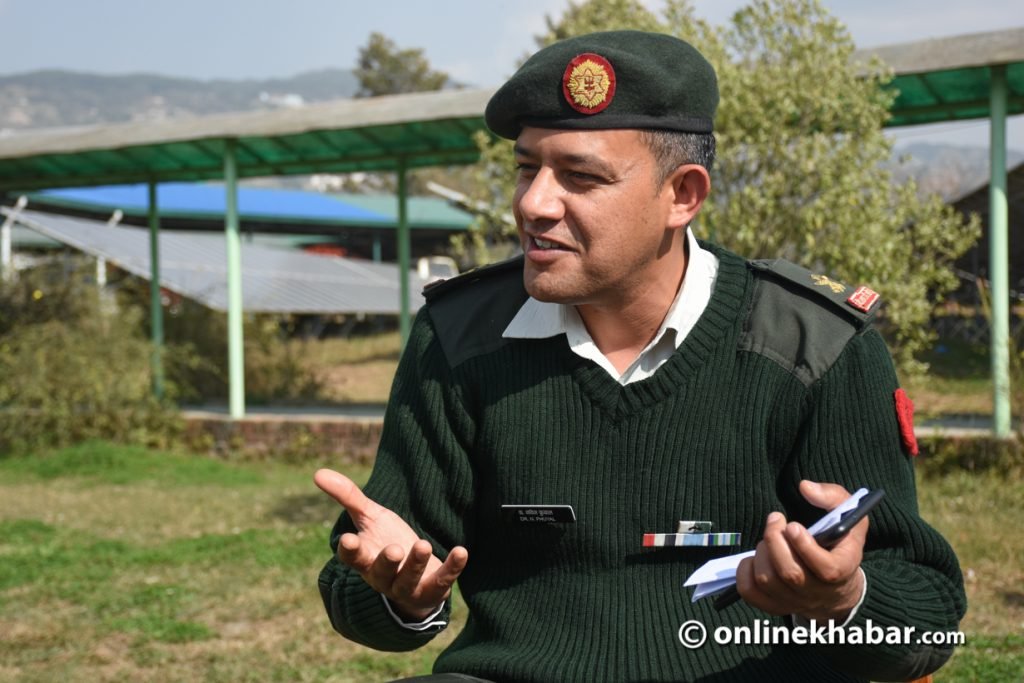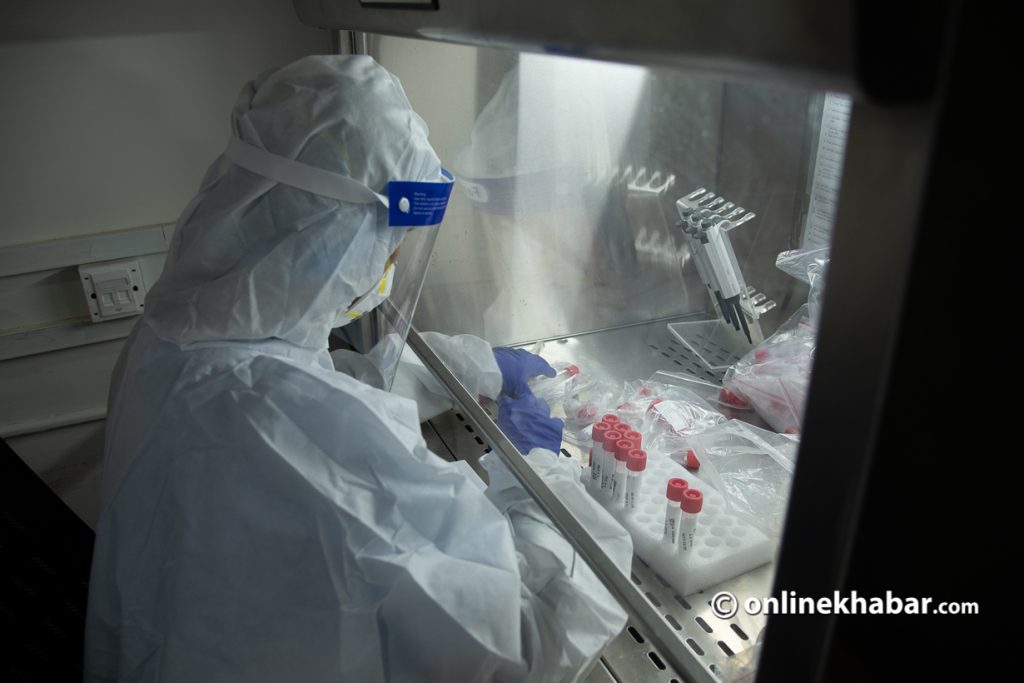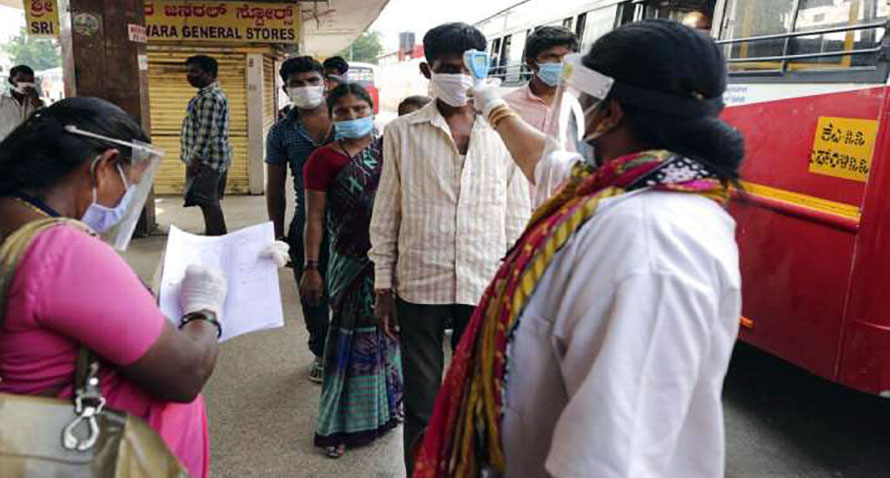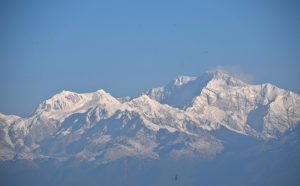 Two months ago, before the coronavirus infection became a pandemic or before the World Health Organisation declared that Nepal also was at a higher risk of the virus spread, Nepal Army’s Disaster Response and Management Cell had already started their preparations to study the situation.
Two months ago, before the coronavirus infection became a pandemic or before the World Health Organisation declared that Nepal also was at a higher risk of the virus spread, Nepal Army’s Disaster Response and Management Cell had already started their preparations to study the situation.
While their study was still ongoing, the government called a meeting with the stakeholders including the Brigadier General at the army’s Health Directorate, Dr Sunil Kumar Singh, and officials of the Ministry of Health, the Ministry of Tourism, and the Ministry of Foreign Affairs.
During the meeting, many officials shot the same question to the army: There are Nepalis in China, what are Nepal Army’s preparations for it? To that, an official replied that they had not been involved with such matters before; there had been no departments to look after it. Yet, he assured that they would do the needful.
The army, then, was given the responsibility to evacuate the countrymen and women from China. The meeting also directed the army to finalise a place for the necessary quarantining of the evacuated people in coordination with Nepal Police and Armed Police Force.
—
On January 28, China declared a lockdown on Wuhan province following 4,500 confirmed coronavirus cases including over 100 deaths. With the news, pressure from the common people increased, demanding to evacuate the Nepali citizens from the virus-hit area of China.
Among the few proposed places, the officials decided that the Nepal Electricity Authority’s training centre in Kharipati of Kathmandu could be a suitable place for the quarantine. Soon after, the army began the evacuation process as ‘COVID-19 Nepal’, under the command of Major General Prabhu Ram Sharma.
But when the security personnel finalised Kharipati for the quarantine, the locals were prompt to show their disagreement on the decision, with some even leaving their homes.
 “The people in Kharipati were misinformed and were thinking that we were evacuating people who had already contracted the virus,” said epidemic expert, Major Dr Nabin Phuyal. “In coordination with the Bhaktapur District Administration Office, Nepal Red Cross Society and other local organisations, we went around the area to clarify that we were bringing those who were not infected by the virus. Then, they cooperated,” adds Phuyal.
“The people in Kharipati were misinformed and were thinking that we were evacuating people who had already contracted the virus,” said epidemic expert, Major Dr Nabin Phuyal. “In coordination with the Bhaktapur District Administration Office, Nepal Red Cross Society and other local organisations, we went around the area to clarify that we were bringing those who were not infected by the virus. Then, they cooperated,” adds Phuyal.
Phuyal remembers that the coordination from all concerned government offices made the process easier.
Following the finalisation of the quarantine site, the team of 50 security personnel from Nepal Army, Armed Police Force, Nepal Police and officials from the Ministry of Health, and aeroplane crew assigned for the task were given special training. The training included guidelines like how to wear personal protective elements (PPE), how to wrap the seats with plastic in the aeroplane, how to provide food to the passengers and also briefings about important parts of the plane.
They even studied the aeroplane, its air pressure and airflow inside it, and how it would affect the patients onboard.
Meanwhile, the Ministry of Foreign Affairs, via the Nepali Embassy in China, was collecting all the names of the Nepalis to be evacuated.
—
The rescue team reached China from Nepal, all with the PPE gears and aeroplane seats covered in plastic as planned, on February 15. The Nepali students to be evacuated had already reached the airport and they were waiting for the aircraft. There, Chinese health officials had already conducted a round of temperature screening. Six Nepalis were asked to not to leave China because they had a fever.
The plane had carried a four-member team to handle medical emergencies on board, three pilots, seven cabin crew, an engineer, a flight departure master and a loadmaster. To minimise contacts, the rescue team was kept separately in the business compartment. The food to be served during the four-hour flight from Wuhan to Kathmandu was also placed on the patients’ seats to minimise further content.

On February 16, before 4 am, the Nepal Airlines’ wide-body aircraft airlifted 175 Nepalis to Kathmandu. Here at the airport, the aeroplane was given a separate runway. A separate location with a total of five sections for their arrival was prepared. After a thermal screening, the group was taken to Kharipati for quarantine on five tourist buses.
The bus drivers were also trained about the safety measures that they should adopt. The drivers had first shown reluctance to drive the vehicles, fearing infection, but had agreed after their compartments were sealed.
The aeroplane was kept on hold at the TIA parking lot for the next 48 hours before it was eligible to fly again.
—
At Kharipati, the evacuated Nepalis were kept inside four buildings of the NEA training centre. Only two to three people were kept in a room, Major Phuyal informs.
“The room partners were finalised based on the patients’ choice. Many of them were familiar with each other; some even studied in the same university. They were happy while staying in the quarantine,” says Phuyal.
On the very first day of their arrival, the quarantine management team had taken the swab samples of all 175 people. The army officials went person-to-person to check their temperature and distributed booklets on the prevention measures against COVID-19.

The control room there used to keep records of the temperatures twice a day, with the army officials making rounds to check if the screening was being held properly or not. Besides, everyone was given strict guidelines to call and report any kind of temperature fluctuation immediately.
Everyone in the management team was worried about what to do if any of the evacuees showed any symptoms of infection. Fortunately, during the 16-day quarantine, nobody complained any such. There were only a few complaints of stomachache, informs Phuyal.
After 16 days, the quarantine team and the evacuated Nepalis exited Kharipati. On that day, the locals who had previously left the area fearing the virus infection and were sceptic of their move in the quarantine thanked the Nepal Army officials with garlands around their necks.
Even some family members of the army officials involved in the process were not in favour of the officials’ role, fearing risks. “Our job is very ironic. If we do not do it, no one would. There were a lot of scepticism and negative comments about the move. Hence, we restricted our stay here, rather than giving priority to what was being said outside,” shares Phuyal, remembering how hard it was to convince their families. “But all was worth it in the end; we got the needed support from all the stakeholders and we did our work.”
The result was apparent: on Tuesday this week, everyone had a big smile on their faces while exiting the quarantine.

























